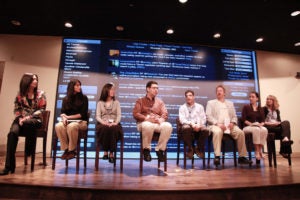April 5, 2011 | Digital Divide, Featured, Metrics and Analytics, Research, Transition to Digital
Reflections: Beyond News Routines, Beyond News Consumption

Beyond News Routines, Beyond News Consumption, an ISOJ panel chaired by UT-Austin’s Tom Johnson, worked as a smooth transition from Friday’s panels on cutting-edge innovations of news industry.
The research panel included Ahmed El Gody of Orebro University, Sweden, Angela Lee from University of Pennsylvania, Jonathan Groves of Drury University and Carrie Brown of University of Memphis, and H. Iris Chyi, Monica Chadha, Ingrid Bachmann, Summer Harlow, and Brian Baresch of UT Austin.
Chyi and Chadha of UT-Austin started off the discussion by presenting their research result on the efficiency of presenting news on multiple platforms. (PDF Paper).
Chyi said the “newsfulness,” or the degree to which a multi-purpose device is used for news access, is still very low for new devices. According to their research, majority of the public used only one device for news access and only 8.5% used more than three devices for news.
“Newer devices are not enjoyable when used for news,” Chyi said.
In a brief interview after the panel discussion, Chyi said new electronic devices such as iPad are likely to remain niche devices for a small portion of people, and may not be popular like computers or TVs in penetration rates.
“But it’s a closed network for new devices. The control is moving from users to back to publishers again,” Chyi said.
El Gody examined the utilization of Information Communication Technologies (ICTs) inside Egyptian newsrooms. (PDF Paper).
He said the Al Ahram newsroom that he examined had only seven computers for its 190 staff members, but added that Egyptians are by far the most engaged social activist users in Middle East region.
His research concluded Egyptian revolution was not only started by Facebook but ICTs such as the independent media and mobilization made it possible.
Lee followed, and her research on how top 10 U.S. news sites use medium-specific features noted that news sites need to move beyond just focusing on contents but consider making the use of online news as a distinctive medium. (PDF Paper).
UT-Austin doctoral students Ingrid Bachmann and Summer Harlow presented the use of interactive and multimedia features in Latin America newspaper websites. (PDF Paper).
Their results noted that Latin America newspapers are slow to adopt more interactive and participatory features and still following a print-first mentality.
Groves and Brown’s case study on the Christian Science Monitor showed a successful example of transitioning from print to web-only media. Noting a fundamental conflict between the Monitor’s ideal and success of page views, Groves said the Monitor has nevertheless adopted a successful new model. (PDF Paper).
Finally, Baresch’s team focused on how news travels on social networks. (PDF Paper).
“About half of Americans rely on the people around them to find out what they need to know,” Baresch said.
The research suggested that frequent linkers on Facebook tend to have a particular topic and genre of interest. Baresch also said that we are moving from “ink economy” to “link economy.”
ISOJ 2011: Research – Beyond News Routines, Consumption Q&A, from Knight Center on Vimeo.

